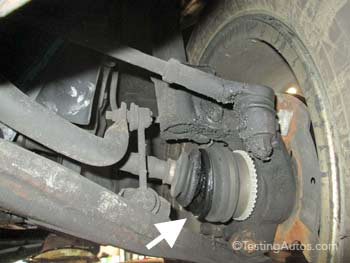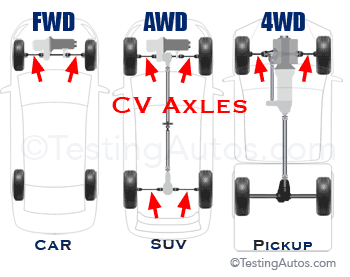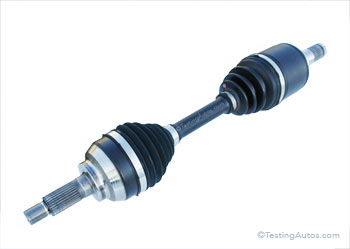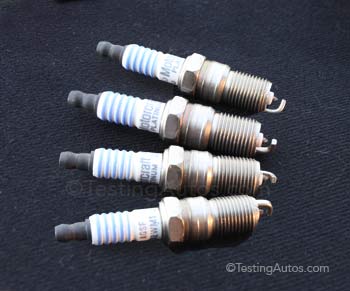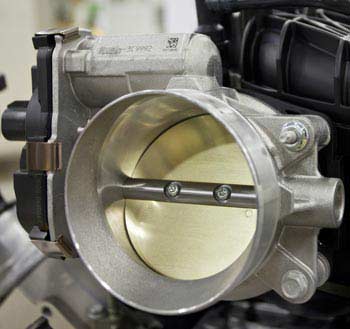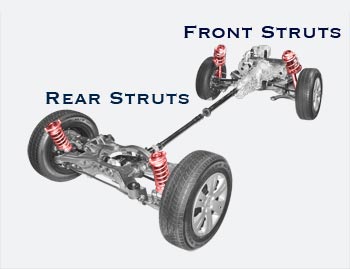When does a CV axle need to be replaced?
Updated: March 21, 2020
What is a CV axle? It's a shaft with constant-velocity (CV) joints that transfers the rotating torque to one of the drive wheels in a car. It might also be called a half shaft or drive shaft. A typical front-wheel drive car has two CV axles (CV shafts), one at each front wheel.
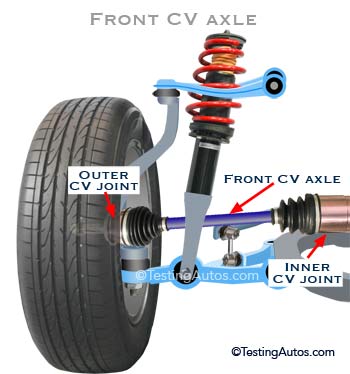 Front CV axle. See also: CV axles in AWD vehicle.
Front CV axle. See also: CV axles in AWD vehicle.When should a CV axle be replaced? In most auto repair shops, mechanics inspect CV axles visually during regular oil changes. A CV axle only needs to be replaced if there is a problem with it; read more below.
How does a CV axle work? A CV axle is needed if a vehicle has an independent suspension on drive wheels. In an independent suspension, the left and right wheels move up and down following the road surface independently of each other. To transfer the torque to a wheel that is constantly moving and, in the case of front wheels, turning left and right, a CV axle must have joints that can transfer rotating motion under angle. In addition, the length of the shaft must be flexible.
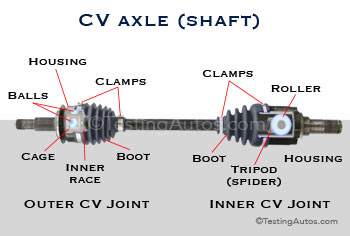 Typical CV axle (shaft) of a front wheel drive car with a Rzeppa outer CV joint and closed tripod-style inner joint.
Typical CV axle (shaft) of a front wheel drive car with a Rzeppa outer CV joint and closed tripod-style inner joint. The Rzeppa-type outer CV joint like the one in the image is the most common type. Some rear-wheel drive cars use cross groove joints that look a bit different inside, but work in a similar way. See the diagram of the rear cross-groove CV axle.
When does a CV axle need to be replaced? The most common reason to replace a CV axle is when a boot breaks (in the photo), allowing the grease to leak out. Without proper lubrication, a CV joint will not last long. See the photo of a bad CV axle. Other reasons to replace a CV axle include excessive wear or damage in an accident or due to excessive rust.
If a bad CV axle is not replaced in time, it might separate or jam while driving resulting in a safety hazard.
In cars and SUVs with a transversely mounted engine, one of the CV axles is longer (typically the right side), and includes a hanger bearing. If a hanger bearing is worn out or noisy and cannot be replaced separately, the whole CV axle is also replaced.
What are the symptoms of a bad CV axle? One of the common symptoms of a bad outer joint is a clicking noise when accelerating in turns. A CV axle that is excessively worn can produce a clunking or clicking noise when shifting between decelerating and accelerating. If an inner joint is worn out or sticking, it can cause the vehicle to shake laterally (side to side) on acceleration. In some cases, a bad CV axle can cause a vibration.
How much does it cost to replace a CV axle? In a typical small or medium front-wheel drive car, replacing one front CV axle with an aftermarket part costs from $180 to $410. OEM parts are more expensive, but the OEM quality is often better. Replacing rear CV axles tends to be more expensive due to extra labor. Do both CV axles need to be replaced at the same time? No, it's not necessary; there is no need to replace a CV axle if it's in good shape.
OEM versus Aftermarket CV axles: Some aftermarket CV axles work as well as OEM parts. However, we know of a couple cases when aftermarket CV axles wore out prematurely. In both cases, worn aftermarket CV axles were producing clicking/clunking when switching between acceleration and deceleration at slow speed. We would recommend OEM parts if the price difference is not too great. The CV axle quality is especially important if the vehicle has a strong engine.
Can you save a CV axle by replacing only a broken boot? Yes, if you catch it early and the grease hasn't leaked out or water hasn't gotten in yet, it's one of the possible solutions. If a CV axle boot has been broken for a while, like in this photo, the axle will need to be replaced. It usually comes down to which option is more cost-effective, as well as time and part availability.
In some cases, replacing a boot only requires more labor.
Advertisement
What are the early signs of a broken CV axle boot? If you look at the photo with a broken boot above, you can see the grease splashed all over inside the wheel. Often, you can see the grease spots on the rim from the outside that appear there soon after the boot broke.
The good news is that CV axles in most cars are covered by the powertrain warranty, which is typically 5 years or 60,000 miles. Check your warranty brochure for details. How long do CV axles last? In many cars, if the protective boots are not broken, CV axles can last for the lifetime of the car.
Read Next:
When does a wheel bearing need to be replaced?
When should the transfer case oil be changed?
When does the axle seal need to be replaced in a car?
How often do brakes need to be serviced?
When do the control arms need to be replaced?
When to replace sway bar links?
How often do brakes need to be serviced?
When does a wheel bearing need to be replaced?
When should the transfer case oil be changed?
When does the axle seal need to be replaced in a car?
How often do brakes need to be serviced?
When do the control arms need to be replaced?
When to replace sway bar links?
How often do brakes need to be serviced?
